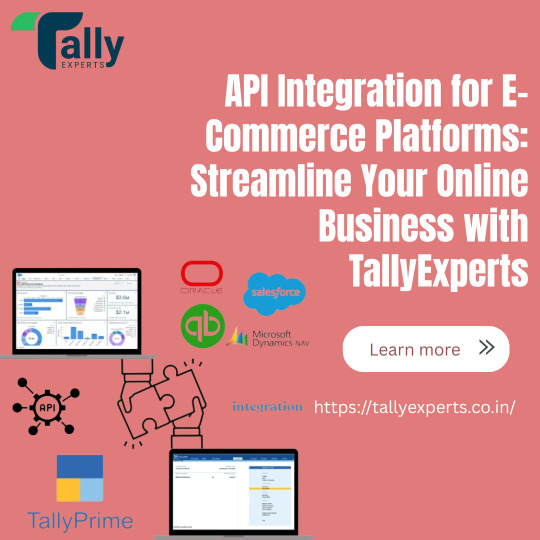#API Integration
Explore tagged Tumblr posts
Text
Abathur

At Abathur, we believe technology should empower, not complicate.
Our mission is to provide seamless, scalable, and secure solutions for businesses of all sizes. With a team of experts specializing in various tech domains, we ensure our clients stay ahead in an ever-evolving digital landscape.
Why Choose Us? Expert-Led Innovation – Our team is built on experience and expertise. Security First Approach – Cybersecurity is embedded in all our solutions. Scalable & Future-Proof – We design solutions that grow with you. Client-Centric Focus – Your success is our priority.
#Software Development#Web Development#Mobile App Development#API Integration#Artificial Intelligence#Machine Learning#Predictive Analytics#AI Automation#NLP#Data Analytics#Business Intelligence#Big Data#Cybersecurity#Risk Management#Penetration Testing#Cloud Security#Network Security#Compliance#Networking#IT Support#Cloud Management#AWS#Azure#DevOps#Server Management#Digital Marketing#SEO#Social Media Marketing#Paid Ads#Content Marketing
2 notes
·
View notes
Text
Connect SMSGatewayCenter SMS & WhatsApp API with MoEngage | Step-by-Step
Learn how to integrate SMSGatewayCenter’s SMS and WhatsApp Business API with MoEngage as a custom connector! 📱 This step-by-step tutorial guides you through setting up seamless, TRAI-compliant SMS and WhatsApp campaigns for your business. Perfect for marketers, developers, and businesses in India looking to boost engagement with personalized messaging. 🚀 Follow along and start automating your campaigns today with SMSGatewayCenter!
👉 Get started: https://www.smsgatewaycenter.com/
📢 Subscribe for more tutorials: https://www.youtube.com/@SMS.Gateway.Center
💬 Have questions? Drop them in the comments!
🔗 Related guide: https://www.smsgatewaycenter.com/integrations/connect-moengage-sms/
#SMSGatewayCenter#MoEngage integration#bulk SMS API#WhatsApp Business API#SMS marketing#WhatsApp marketing#DLT compliance#TRAI regulations#custom connector#SMS campaigns#WhatsApp campaigns#business automation#Mumbai businesses#digital marketing#API integration#SMS Gateway Center#MoEngage tutorial#SMS for business#WhatsApp for business
2 notes
·
View notes
Text
Woxro: The Bright Head in the Lead of Ecommerce Development
Woxro is one of the highest level e-commerce development companies in the constantly changing digital economy. Woxro assures cutting-edge solutions for businesses with the sophisticated requirement of today's digital economy. Whether it's about B2B and B2C platforms or the most seamless integration, or simply a custom-built solution, the online business experiences get ignited through Woxro's services. Backed with the attitude of innovation and commitment towards making their clients successful, Woxro helps companies make strong digital platforms along with competitive markets. Check out these are the core e-commerce development services by which Woxro comes forward to be a preferred partner for businesses wanting to breathe new life into their online presence. Woxro is the leading ecommerce development company in India and is providing top notch services and solutions for you.

B2B Platform Development
The B2B interaction is at the heart of modern commerce; it has built B2B platforms that make such interactions easy and hassle-free. B2B marketplaces help a company reach its suppliers, shortlist potential partnerships, and make the transactions all from one centralized place. Woxro's B2B platforms are wide-ranging and ensure that customers experience security, reliability, and ease of use in all business operations in order to create confidence and efficient workflows. Woxro's B2B solutions are equipped with real-time inventory management, automated processes, and advanced analytics, meaning businesses can work efficiently and have valuable relationships that last long.
B2C Platform Development
Through ease-of-use, online shops to offer products for shopping, Woxro's B2C platform development services help businesses reach their customers and interact directly with them. Designed to convert visitors into loyal customers, Woxro's B2C platforms include all the comprehensive tools for managing products, processing secure payments, and engaging in more personalized experiences for shopping. Each is optimized to give an easy, enjoyable experience to the user as businesses stretch their reach to the customer, marketing being directed, and giving an enjoyable shopping experience that creates a sale and brand loyalty.

Platform Migration
Moving out from the outdated systems to modern scalable platforms often marks the beginning for businesses that want to remain competitive. Woxro professionals successfully migrate complexly numerous business operations from less than the minimum level of disruption. Woxro takes cautious control of data migration, system configuration, and testing processes while making the move to become more distant in terms of on-premise systems to cloud infrastructure, updating legacy technology, or changing platforms. When businesses engage with Woxro, they embrace the latest technologies, realize cost savings on operations, and boost the performance of the system with business continuity and efficiency intact.
Custom-Designed Platform Development
Woxro realises that every business is unique and has custom platform development services that provide bespoke solutions for a specific goal or workflow in place. These platforms are off-the-shelf by definition, designed from the ground up to meet a precise business need. Woxro's custom solutions are scalable and adaptive, allowing businesses to implement proprietary features, streamline workflows, and maximize flexibility. About Woxro's customization innovation integration: It ensures that the platforms continue to grow with the business and, thus, become an excellent basis for long-term growth as well as a competitive edge in the market.
CMS Integration
The integration of a content management system with your e-commerce platform has vast benefits within the operation, ranging from effective product management to advanced SEO capabilities. Woxro's content management system integration services enable businesses to access a single, easy-to-use interface for managing product descriptions, optimizing search content for better search engine rankings, and personalising shopping experiences. CMS integration, therefore, promotes ease of updates while bringing increased online visibility and engagement from customers. CMS integration helps companies create more engaging and dynamic experiences that talk to customers to convert them.
API Integration
API integration is a necessary concept for e-commerce platforms in an interlinked digital world, integrating with third-party applications, payment systems, and other services. Woxro's API integration services provide smoother interoperability between different software applications for easy information sharing and add-on features. Of course, payment gateway, CRM system, and APIs all resolve issues because their performance can grow without getting disconcerting of existing operations, Woxro ensures that. API integration makes the overall functionality and responsiveness of e-commerce platforms robust, flexible, and scalable enough to expand on further expectations.
Why Woxro for ECommerce Development?
At Woxro, you will find industry expertise, innovative technology and, above all, a client-centric approach that seeks tailored solutions for each business. Ecommerce development with Woxro's services is done to cater for the unique needs of every client so as to ensure robust, scalable solutions adapting to changing market demands. Whether it is a B2B, B2C platform, handling platform migrations, or integration with CMS and APIs, Woxro connects with technical pools of expertise in alignment with strategic insight to yield results. Businesses partner with Woxro to achieve advanced tools and custom solutions in enforcing the new path forward through their digital success.

Conclusion
Woxro e-commerce development solutions give businesses the possibility of a powerful and agile web presence. The products offered by Woxro for creating B2C growth strengthen customer engagement, streamline B2B relations, smooth migrates, and unlock API and CMS integrations that facilitate business clients' digital transformation with the platform. Equipping businesses with solutions that solve the challenges of the digital age, creating future-proof, impact-generating e-commerce, to drive business growth and success-all of these Woxro does.
#ecommerce#ecommerce development agency#ecommerce development services#ecommerce development company#ecommerce website development#ecommerce developers#web developers#web development#web graphics#web resources#shopify#woocommerce#online store#smallbusiness#websitedevelopmentcompany#search engine optimization#web design#website design#web hosting#website#social media#content creation#content creator#cms development services#cms#b2b#b2bmarketing#api integration
5 notes
·
View notes
Text

🌟 SmilePayz Payment Solution: Covering All Industries, Seamless Integration! 🌟
SmilePayz specializes in Indonesia, Thailand, Brazil, and Mexico, offering cryptocurrency payment solution as well. Since we are a direct payment source for these countries, we can provide the lowest rates in the market. We also offer same-day settlement/D0 settlement!
✅ Easy Integration: Diversified API interfaces for quick system compatibility, improving efficiency. ✅ 24/7 Support: Professional service around the clock, ensuring peace of mind.
Whether you're in online gaming, forex, online casino, live streaming, entertainment, forex, or financial services, SmilePayz is your best payment solution! [We do not accept business that is related to pornography and scamming.
🌐 Contact us now to experience more convenient and secure payment services!
Telegram: @Thompson7837
Telegram: @Thompson7837
Telegram: @Thompson7837
#payment gateway#api integration#high risk payment processing#high risk payment gateway#paymentsolutions#payment#payments#e commerce#online gambling#forex
2 notes
·
View notes
Text

This blog post will give you an in-depth look at everything from API integration to connecting your switch with channel management systems, streamlining the operations performance of the hotel business. Learn More...
#API Integration#hotel integration#VoIP#voip services#voip technology#voip system#voip solutions#business voip#voip phone#VoIP Protocol#unified communications#cloud technology#hotel phone installation#ip telephony#phonesuite pbx#SIP Protocol#Call booking#hotel hospitality#hotel pbx#Call center#Hotel hospitality#Business voip#VoIP system#Voip service
2 notes
·
View notes
Text

Acemero is a company that strives for excellence and is goal-oriented. We assist both businesses and individuals in developing mobile and web applications for their business.
Our Services include:
Web/UI/UX Design
CMS Development
E-Commerce Website
Mobile Apps
Digital Marketing
Branding
Domain & Hosting
API Integration
Our Products include :
Support Ticket System
Direct Selling Software
Learning Management System
Auditing Software
HYIP Software
E-Commerce Software
#Mobosoftware#software development#software developers#web development#cms web development services#cms website development company#cms#mlm software#hyip#ecommerce software#lms#audit software#API Integration#Branding#Digital Marketing#ui/ux design
2 notes
·
View notes
Text

Pell Software is proud to announce that we have been selected as a top US software development company by Techreviewer.co in 2024, for the second year running!
Our top rated software engineering team has helped hundreds of clients grow and improve their businesses by streamlining their operations and integrating their data.
We're excited for another year full of opportunities to help our clients grow and we're proud to be recognized for such an award!
#business software#custom software development#api integration#quickbooks#custom software solutions#custom software#quickbooks enterprise#custom web application development#quickbooks integration#software development
1 note
·
View note
Text
Network APIs: The Unseen Force Driving Next-Gen Digital Experiences
The world runs on connectivity, and at its very foundation, an increasingly powerful and dynamic layer is emerging: Network APIs (Application Programming Interfaces). These aren't just technical curiosities; they are the programmable interfaces that are democratizing access to complex network capabilities, fueling a surge in innovation, and reshaping the business models of telecommunication companies (telcos).

Beyond Basic Connectivity: What Network APIs Offer
Historically, interacting with a network meant dealing with a labyrinth of proprietary systems and specialized protocols. Network APIs dismantle these barriers, offering a standardized, simplified way for developers and enterprises to tap into the very core functionalities of modern networks. This opens up a world of possibilities, enabling applications to:
Gain Network Intelligence: Applications can access real-time data about network conditions, device location (with user consent), network congestion, and even SIM card details. This intelligence allows for smarter, more adaptive applications.
Influence Network Behavior: Far from passive observers, applications can now request specific network behaviors, such as reserving bandwidth for critical services (Quality on Demand), creating isolated "slices" of the network for specialized use cases (Network Slicing), or managing device connectivity in real-time.
Enhance Security and Authentication: Network APIs provide powerful tools for fraud prevention, including SIM swap detection, phone number verification, and leveraging network intelligence to identify suspicious patterns in transactions. This is critical in an era of escalating cyber threats.
Automate and Optimize: For telcos themselves, Network APIs facilitate the automation of network management, provisioning, and troubleshooting. This leads to significant operational efficiencies, reduced manual errors, and faster service delivery.
The Catalysts: 5G, AI, and Standardization
The rise of Network APIs is inextricably linked to two transformative technologies and a critical industry movement:
5G: The architectural shift to 5G, with its focus on a service-based architecture, network slicing, and ultra-low latency, inherently lends itself to API exposure. 5G makes networks programmable and flexible, providing a rich canvas for developers to create differentiated services that were impossible with previous generations. Use cases like real-time AR/VR, connected vehicles, and industrial automation heavily rely on the granular control and insights 5G Network APIs provide.
Artificial Intelligence (AI) and Machine Learning (ML): AI is becoming the "brain" behind Network APIs. AI models analyze the massive volumes of data generated by 5G networks, enabling predictive maintenance, dynamic resource allocation, and intelligent traffic management. APIs serve as the interface to these AI models, allowing applications to leverage sophisticated analytics for tasks like optimizing content delivery, personalizing user experiences, and enhancing security. Autonomous APIs, capable of self-adjusting and optimizing, are an emerging trend.
Standardization Initiatives (e.g., GSMA Open Gateway, CAMARA Project): For Network APIs to achieve widespread adoption, interoperability is key. Efforts by organizations like GSMA and projects like CAMARA are crucial in defining standardized API interfaces. This ensures that developers can build applications that work seamlessly across different mobile network operators globally, fostering a vibrant and competitive ecosystem.
Emerging Trends and Future Outlook
The Network API landscape is evolving rapidly, with several key trends shaping its future:
API-as-a-Product Mentality: Telcos are increasingly treating their Network APIs as standalone products, complete with developer portals, documentation, and monetization models (usage-based pricing, subscriptions, freemium). This shift encourages external developers to consume and build upon network capabilities.
Microservices Architecture: Network APIs often underpin microservices, allowing modular and independently deployable services to combine and form larger, more complex applications. This enhances flexibility, scalability, and development speed.
API Marketplaces and Developer Ecosystems: The growth of centralized hubs where businesses can discover, purchase, and integrate third-party network API-driven services is accelerating. This fosters collaboration and reduces the need for custom solutions.
Enhanced Security: With more capabilities exposed via APIs, security becomes paramount. Trends include automated security testing, built-in rules for detecting malicious activity, and comprehensive API posture management solutions.
Event-Driven Architectures: Beyond traditional RESTful APIs, event-driven APIs are gaining traction for real-time systems, allowing applications to react to network changes as they happen, crucial for dynamic 5G environments.
Edge Computing Integration: As data processing moves closer to the source, Network APIs will be vital conduits between edge devices and centralized platforms, enabling local decision-making and low-latency interactions.
Network-as-a-Service (NaaS): Network APIs are a cornerstone of the NaaS model, where network capabilities are offered as consumable services, empowering enterprises to dynamically provision and manage their connectivity requirements on demand.
The Promise: Unlocking New Value
The true power of Network APIs lies in their ability to unlock new revenue streams for telcos, accelerate digital transformation for enterprises, and deliver unparalleled user experiences. From enabling highly secure financial transactions and ultra-reliable connected cars to facilitating immersive entertainment and efficient smart city solutions, Network APIs are the unseen force driving the next wave of digital innovation. As the ecosystem matures and standardization gains momentum, we can expect Network APIs to become an indispensable layer in the programmable, intelligent networks of tomorrow.
Read more:
WaveXD - Network API’s
Ai Auto code
AI Wave maker
Rapid low code application development platform
Low code platform Enterprise software for application development
Low code application development platform or Low code platform for application development
What is Low code app development platforms
Composable low code isvs
Java-based low code platform
Composable isvs
RAD studio-Rapid application development software platform
APAAS-application platform as a service
Cloud Low code application development platform
Legacy application modernization solutions
React-native cross-platform mobile application development platform
Compare Wavemaker vs Outsystems vs mendix vs power apps — low code alternatives and its pricing
New and fast application development platform
Rapid application development model or RAD model
Low-code for consumable Banking and financial Low-code platform solutions
Internal api vs external apis
Rapid application development vs SDLC Platform
Custom Enterprise low code application development platform
Legacy enterprise application Modernization Platform
Embedded banking and Finance, Low-Code and the Emerging Face of Adaptability
BAAS- Low code Banking as a service
Composable Low code banking solutions
Telecom low code platform
Alternative to Xamarin and Cordova
Wavemaker Low code
Legacy application modernization platform
Cross-Platform React Native Mobile App Development Platform
1 note
·
View note
Text
What Is API Integration? A Beginner’s Guide for Businesses
In today’s fast-paced digital landscape, businesses must adopt smarter ways to connect systems, automate workflows, and improve efficiency. One of the most powerful tools driving this evolution is API integration. But what exactly is an API, and how does it benefit your business?
This guide breaks down the fundamentals of API integration in simple, non-technical terms — perfect for entrepreneurs, business owners, product managers, and startup teams. Learn how APIs (Application Programming Interfaces) enable different software applications to communicate and exchange data seamlessly. Discover how API integration can help you streamline operations, reduce manual work, improve customer experience, and enable real-time data flow across platforms like CRMs, ERPs, payment gateways, and more.
We also explore key use cases, industries benefiting from APIs, and practical insights into selecting the right integration strategies for your business. Whether you're running an e-commerce platform, managing enterprise systems, or building a SaaS product, understanding API integration is no longer optional — it’s essential.
By the end of this article, you'll have a solid foundation on what API integration is, why it matters, and how it can be a game-changer for your growth and scalability.
#API Integration#What is API#Business Automation#Digital Transformation#REST API#Web Services#Software Integration#API for Business#Cloud Integration#Business Technology#Enterprise APIs#SaaS Integration#API Examples#API Integration Guide#System Integration
0 notes
Text
In today’s digital-first world, businesses are under immense pressure to optimize operations, reduce costs, and improve partner communication. EDI Software Solutions have emerged as the backbone of digital transformation, enabling secure and standardized data exchange across systems and partners through electronic data interchange. From healthcare EDI to supply chain automation, the scope and relevance of EDI systems are expanding fast.However, not all EDI solutions are created equal. The right EDI tool can make a monumental difference in efficiency, compliance, and collaboration. Whether you're integrating with EMR software solutions, EHR software solutions, or simply looking to enhance B2B integration, this guide outlines the top 10 must-have features in a modern EDI software solution.
#EDI Software Solutions#EDI Integration#Electronic Data Interchange#EMR Software Solutions#EHR Software Solutions#Healthcare EDI#B2B Integration#Supply Chain Automation#EDI Features#EDI Tools#Custom Healthcare Software#HL7 Integration#X12 Standard#API Integration#Healthcare IT Solutions#Digital Transformation#Custom Software Development#Data Exchange Solutions#Cloud-Based EDI#EDI for Healthcare
0 notes
Text
API Integration for E-Commerce Platforms: Streamline Your Online Business with TallyExperts

In the fast-evolving world of online retail, Tally API integration for e-commerce platforms has become not just a technical upgrade—but a business necessity. With customers demanding faster service, seamless experiences, and instant updates, your e-commerce system must be tightly integrated with back-end systems like Tally ERP. This is where TallyExperts steps in—offering robust, scalable, and tailor-made API integration services for all major e-commerce platforms.
Whether you're a small startup or a large retail brand, integrating your e-commerce website with Tally through API not only automates your accounting and inventory updates but also reduces errors, saves time, and enhances operational efficiency. In this comprehensive guide, we’ll explore what API integration for e-commerce platforms means, why it's crucial, and how Tally Experts can help you achieve a streamlined digital ecosystem.
What is API Integration for E-Commerce Platforms?
API stands for Application Programming Interface—a set of rules that allow different software applications to communicate with each other. In the context of e-commerce, API integration involves connecting your online store (built on platforms like Shopify, WooCommerce, Magento, Amazon, or Flipkart) with Tally ERP or other third-party applications like CRM, logistics, or payment gateways.
This integration ensures that various functions such as order processing, stock updates, customer data management, invoice generation, and financial accounting happen in real-time—without the need for manual intervention.
Why is API Integration Essential for E-Commerce?
As online shopping becomes the new normal, e-commerce businesses are handling hundreds—if not thousands—of transactions daily. Manually updating every order, stock level, and invoice in Tally or any other system is not only time-consuming but also error-prone.
Here are some of the key reasons why Tally api integration for e-commerce platforms is a must:
1. Automated Accounting Entries
API integration helps in automatically recording sales orders, purchase orders, credit notes, and other financial entries directly into Tally ERP as soon as a transaction occurs on your online platform.
2. Real-Time Inventory Sync
Maintain accurate stock levels across all your channels. Tally api integration allows Tally to update your e-commerce platform with the latest inventory information, preventing overselling or stockouts.
3. Faster Order Processing
Seamlessly transfer order details from your website to your order fulfilment or accounting software, eliminating the need for manual data entry.
4. Error Reduction
API integration eliminates human errors that can occur during manual data handling, such as duplicate entries, wrong SKUs, or mismatched invoices.
5. Improved Customer Experience
Accurate order tracking, instant invoices, and timely shipping updates—all powered by a connected backend—lead to happier and more loyal customers.
Popular E-Commerce Platforms We Integrate with Tally
At TallyExperts.co.in, we specialize in API integrations with the most widely used e-commerce platforms. Our team ensures that your e-commerce system speaks the same language as Tally, resulting in a smooth, automated workflow.
Shopify API Integration
We help Shopify store owners integrate their storefronts with Tally, automating billing, taxation, and inventory updates with real-time data exchange.
WooCommerce Integration with Tally
Get your WooCommerce orders, invoices, and stock reports synced with Tally ERP effortlessly. Our WooCommerce API integration eliminates the need to download order reports manually.
Amazon & Flipkart Seller Integration
If you’re selling through marketplaces like Amazon or Flipkart, we help you automatically pull sales, returns, and payment reports into Tally, saving you hours every week.
Magento Integration
For Magento-based stores, we develop custom API connectors that sync product catalog, order status, tax calculations, and inventory with Tally ERP.
Key Features of Our API Integration Services
At TallyExperts, we understand that each business is unique. Our integration services are fully customizable based on your e-commerce model, accounting requirements, and business processes.
Here’s what sets our service apart:
Bi-Directional Sync
We enable real-time data flow both from your e-commerce platform to Tally and vice versa. This ensures that both systems are always up to date.
Custom Mapping
Custom mapping of fields such as SKU, GST, HSN Code, and Ledger Names to match your specific Tally configuration.
GST & Tax Compliance
Our APIs ensure accurate tax calculation and reporting in line with Indian GST norms, helping you stay compliant.
Secure & Scalable Architecture
We use secure, encrypted APIs that scale as your business grows, ensuring stable performance during high traffic.
Alerts & Reports
Get alerts for failed transactions, pending invoices, and stock mismatches. We also build custom reports as per your need.
How Tally API Integration Works
Our process is simple, transparent, and efficient:
1. Consultation
We begin with understanding your e-commerce setup, accounting structure, and business goals.
2. Feasibility Study
We assess the compatibility between your Tally version and your e-commerce platform. Based on that, we suggest the best integration approach—using standard APIs or building custom middleware.
3. Development & Configuration
We build and configure the API connection, including mapping of data fields and setting up security protocols.
4. Testing & Validation
Our team rigorously tests the integration with real-time data before final deployment to ensure 100% accuracy and stability.
5. Deployment & Training
Once everything is set up, we deploy the integration on your live environment and provide necessary training and documentation.
0 notes
Text
Best Credit Card Payment API Solution Provider in India
Looking for Credit Card API Integrations? Here’s what your company should consider when selecting a credit card processing API: Security: Ensure PCI-DSS compliance and fraud prevention. Seamless Integration: Easy-to-use APIs for quick setup. Scalability: Handle high transaction volumes effortlessly. Multi-Currency Support: Cater to global customers. Real-Time Processing: Instant payment confirmations.
Choose Apiwala’s Credit Card Payment API for secure, reliable, and scalable solutions tailored to your business needs.
Explore Now: https://www.apiwala.com/credit-card-payment-api.html
#CreditCardAPI #PaymentGateway #APIIntegration #FintechSolutions #BusinessGrowth #SecurePayments #TechInnovation #DigitalPayments #PaymentProcessing #APISolutions #DigitalTransformation

0 notes
Text
Eko API Integration: A Comprehensive Solution for Money Transfer, AePS, BBPS, and Money Collection

The financial services industry is undergoing a rapid transformation, driven by the need for seamless digital solutions that cater to a diverse customer base. Eko, a prominent fintech platform in India, offers a suite of APIs designed to simplify and enhance the integration of various financial services, including Money Transfer, Aadhaar-enabled Payment Systems (AePS), Bharat Bill Payment System (BBPS), and Money Collection. This article delves into the process and benefits of integrating Eko’s APIs to offer these services, transforming how businesses interact with and serve their customers.
Understanding Eko's API Offerings
Eko provides a powerful set of APIs that enable businesses to integrate essential financial services into their digital platforms. These services include:
Money Transfer (DMT)
Aadhaar-enabled Payment System (AePS)
Bharat Bill Payment System (BBPS)
Money Collection
Each of these services caters to different needs but together they form a comprehensive financial toolkit that can significantly enhance a business's offerings.
1. Money Transfer API Integration
Eko’s Money Transfer API allows businesses to offer domestic money transfer services directly from their platforms. This API is crucial for facilitating quick, secure, and reliable fund transfers across different banks and accounts.
Key Features:
Multiple Transfer Modes: Support for IMPS (Immediate Payment Service), NEFT (National Electronic Funds Transfer), and RTGS (Real Time Gross Settlement), ensuring flexibility for various transaction needs.
Instant Transactions: Enables real-time money transfers, which is crucial for businesses that need to provide immediate service.
Security: Strong encryption and authentication protocols to ensure that every transaction is secure and compliant with regulatory standards.
Integration Steps:
API Key Acquisition: Start by signing up on the Eko platform to obtain API keys for authentication.
Development Environment Setup: Use the language of your choice (e.g., Python, Java, Node.js) and integrate the API according to the provided documentation.
Testing and Deployment: Utilize Eko's sandbox environment for testing before moving to the production environment.
2. Aadhaar-enabled Payment System (AePS) API Integration
The AePS API enables businesses to provide banking services using Aadhaar authentication. This is particularly valuable in rural and semi-urban areas where banking infrastructure is limited.
Key Features:
Biometric Authentication: Allows users to perform transactions using their Aadhaar number and biometric data.
Core Banking Services: Supports cash withdrawals, balance inquiries, and mini statements, making it a versatile tool for financial inclusion.
Secure Transactions: Ensures that all transactions are securely processed with end-to-end encryption and compliance with UIDAI guidelines.
Integration Steps:
Biometric Device Integration: Ensure compatibility with biometric devices required for Aadhaar authentication.
API Setup: Follow Eko's documentation to integrate the AePS functionalities into your platform.
User Interface Design: Work closely with UI/UX designers to create an intuitive interface for AePS transactions.
3. Bharat Bill Payment System (BBPS) API Integration
The BBPS API allows businesses to offer bill payment services, supporting a wide range of utility bills, such as electricity, water, gas, and telecom.
Key Features:
Wide Coverage: Supports bill payments for a vast network of billers across India, providing users with a one-stop solution.
Real-time Payment Confirmation: Provides instant confirmation of bill payments, improving user trust and satisfaction.
Secure Processing: Adheres to strict security protocols, ensuring that user data and payment information are protected.
Integration Steps:
API Key and Biller Setup: Obtain the necessary API keys and configure the billers that will be available through your platform.
Interface Development: Develop a user-friendly interface that allows customers to easily select and pay their bills.
Testing: Use Eko’s sandbox environment to ensure all bill payment functionalities work as expected before going live.
4. Money Collection API Integration
The Money Collection API is designed for businesses that need to collect payments from customers efficiently, whether it’s for e-commerce, loans, or subscriptions.
Key Features:
Versatile Collection Methods: Supports various payment methods including UPI, bank transfers, and debit/credit cards.
Real-time Tracking: Allows businesses to track payment statuses in real-time, ensuring transparency and efficiency.
Automated Reconciliation: Facilitates automatic reconciliation of payments, reducing manual errors and operational overhead.
Integration Steps:
API Configuration: Set up the Money Collection API using the detailed documentation provided by Eko.
Payment Gateway Integration: Integrate with preferred payment gateways to offer a variety of payment methods.
Testing and Monitoring: Conduct thorough testing and set up monitoring tools to track the performance of the money collection service.
The Role of an Eko API Integration Developer
Integrating these APIs requires a developer who not only understands the technical aspects of API integration but also the regulatory and security requirements specific to financial services.
Skills Required:
Proficiency in API Integration: Expertise in working with RESTful APIs, including handling JSON data, HTTP requests, and authentication mechanisms.
Security Knowledge: Strong understanding of encryption methods, secure transmission protocols, and compliance with local financial regulations.
UI/UX Collaboration: Ability to work with designers to create user-friendly interfaces that enhance the customer experience.
Problem-Solving Skills: Proficiency in debugging, testing, and ensuring that the integration meets the business’s needs without compromising on security or performance.
Benefits of Integrating Eko’s APIs
For businesses, integrating Eko’s APIs offers a multitude of benefits:
Enhanced Service Portfolio: By offering services like money transfer, AePS, BBPS, and money collection, businesses can attract a broader customer base and improve customer retention.
Operational Efficiency: Automated processes for payments and collections reduce manual intervention, thereby lowering operational costs and errors.
Increased Financial Inclusion: AePS and BBPS services help businesses reach underserved populations, contributing to financial inclusion goals.
Security and Compliance: Eko’s APIs are designed with robust security measures, ensuring compliance with Indian financial regulations, which is critical for maintaining trust and avoiding legal issues.
Conclusion
Eko’s API suite for Money Transfer, AePS, BBPS, and Money Collection is a powerful tool for businesses looking to expand their financial service offerings. By integrating these APIs, developers can create robust, secure, and user-friendly applications that meet the diverse needs of today’s customers. As digital financial services continue to grow, Eko’s APIs will play a vital role in shaping the future of fintech in India and beyond.
Contact Details: –
Mobile: – +91 9711090237
E-mail:- [email protected]
#Eko India#Eko API Integration#api integration developer#api integration#aeps#Money transfer#BBPS#Money transfer Api Integration Developer#AePS API Integration#BBPS API Integration
2 notes
·
View notes
Text

Looking for a secure and scalable SMS API? BhashSMS offers DLT-compliant solutions perfect for OTPs, alerts, and real-time tracking. Trusted by businesses across India, our API ensures fast setup and 24×7 support. 🔗 Visit: https://bhashsms.com/sms-api.php
#sms api#bulk sms#business messaging#bhashsms#otp sms#dlt compliant#sms gateway#api integration#real time tracking
0 notes
Text
Best Practices for API Integration in Next.js Apps
Modern web applications thrive on seamless, efficient, and secure API communication. Whether it's pulling data from a CMS, connecting with a payment gateway, or interacting with a cloud service, API integration is at the core of every high-performance Next.js app.
Next.js, with its server-side capabilities and built-in API routes, offers a flexible environment for creating and consuming APIs. But with flexibility comes the responsibility of integration best practices especially when dealing with sensitive data or mission-critical services.

Why Next.js Is Built for API-Driven Applications
Next.js offers both server-side and client-side rendering, making it ideal for hybrid API workflows. Developers can:
Use getServerSideProps() or getStaticProps() for SSR/SSG-based data fetching.
Utilize /api routes to implement backend logic directly within the app.
Take advantage of built-in middleware for authentication, error handling, and request filtering.
This architectural flexibility is why SaaS companies can scale frontend with Next.js, particularly when their APIs need to serve both dynamic dashboards and SEO-friendly landing pages.
Best Practices for Integrating APIs in Next.js
1. Centralize API Logic
Avoid scattering fetch calls across components. Instead, centralize them using a services directory or a custom hook (useApi) for consistency and maintainability.
2. Use Environment Variables
Secure API keys and sensitive data by using .env.local. Never hardcode tokens in the frontend codebase.
3. Handle Errors Gracefully
Build resilient error handling using try/catch blocks and conditionally render UI based on the state of the API response.
4. Use SWR or React Query
For client-side API calls, libraries like SWR (by Vercel) or React Query help manage caching, loading states, and automatic revalidation.
5. Secure Your APIs
Whether you're calling third-party APIs or building your own endpoints within the Next.js /api folder, security is critical. Learn how to ensure REST API security to prevent unauthorized access, data leaks, and common vulnerabilities like CSRF and XSS.
When Should You Hire an Expert?
As your application scales and API complexities increase especially with third-party integrations, real-time data, or sensitive business logic it’s beneficial to hire Next.js developers who are skilled in scalable architectures, secure integrations, and performance optimization.
Final Thoughts
APIs are the arteries of modern web apps. When combined with the server-side strengths of Next.js, your frontend becomes more powerful, reactive, and tailored to user needs. By following these best practices, you’re not only creating better experiences, you're building a scalable, secure, and resilient application foundation.
0 notes
Text

Pell Software is honored to have earned a spot on the prestigious Clutch 1000 list as one of the top B2B companies worldwide!!
Our custom business software solutions have helped our clients grow and streamline their business operations, and we're very proud to receive such a prominent award.
We'd like to give a big "Thank you!" to our awesome staff and all of our great partners who have helped us continue to achieve excellent results over the years!
#business software#quickbooks integration#custom software development#custom web application development#advertising#marketing#api integration#technology#tech#science
1 note
·
View note